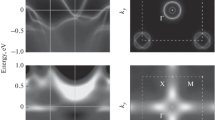Abstract
A self-consistent approach to calculations of the electronic structure and the magnetic susceptibility of nearly magnetic metals, such as palladium and platinum, has been developed in terms of the generalized s(p)d Hubbard model. The energy band structure has been calculated using the ab initio LDA + U + SO method with the additional inclusion of the interstitial s(p)d exchange interaction and spin-fluctuation renormalizations of the electronic spectra, which appear at finite temperatures. The developed approach makes it possible to quantitatively describe the density of states and unusual temperature dependences of the magnetic susceptibility of the nearly magnetic metals under consideration and to evaluate the basic parameters of the electron-electron interactions. The role of the spin-orbit interaction in the formation of the electronic and magnetic properties is enhanced when going from palladium (4d period) to platinum (5d period). The effects of the temperature redistribution of electrons between the s(p) and d states have been revealed.
Similar content being viewed by others
References
K. T. Moore and G. van der Laan, Rev. Mod. Phys. 81(1), 235 (2009).
Y. S. Shi, D. Qian, G. S. Dong, X. F. Jin, and D. Wang, Phys. Rev. B: Condens. Matter 65, 172410 (2002).
D. A. Papaconstantopoulos and B. M. Klein, Phys. Rev. Lett. 35(2), 110 (1975).
Yu. A. Izyumov and V. I. Anisimov, Electronic Structure of Strongly Correlated Materials (RKhD, Moscow, 2008; Springer, Berlin, 2010).
I. Yu. Sklyadneva, A. Leonardo, P. M. Echenique, S. V. Eremeev, and E. V. Chulkov, J. Phys.: Condens. Matter 18, 7923 (2006).
T. Jarlborg, Physica C (Amsterdam) 385(4), 513 (2003).
F. Ladstadter, U. Hohenester, P. Pusching, and C. Ambrosch-Draxl, Phys. Rev. B: Condens. Matter 70, 235125 (2004).
A. O. Shorikov, A. V. Lukoyanov, M. A. Korotin, and V. I. Anisimov, Phys. Rev. B: Condens. Matter 72, 024458 (2005).
A. A. Povzner and A. G. Volkov, Fiz. Met. Metalloved. 66(6), 1073 (1988).
V. I. Grebennikov and Yu. I. Prokop’ev, Fiz. Met. Metalloved. 57(3), 483 (1984).
K. A. Shumikhina, A. G. Volkov, and A. A. Povzner, Fiz. Tverd. Tela (St. Petersburg) 45(6), 996 (2003) [Phys. Solid State 45 (6), 1042 (2003)].
A. G. Volkov, A. G. Andreeva, O. V. Anoshina, and A. A. Povzner, Fiz. Tverd. Tela (St. Petersburg) 44(12), 2217 (2002) [Phys. Solid State 44 (12), 2323 (2002)].
A. G. Volkov, A. A. Povzner, V. V. Kryuk, and P. V. Bayankin, Fiz. Tverd. Tela (St. Petersburg) 41(10), 1792 (1999) [Phys. Solid State 41 (10), 1644 (1999)].
J. A. Hertz, and M. A. Klenin, Phys. Rev. B: Solid State 10(3), 1084 (1974).
I. E. Dzyaloshinskiĭ and P. S. Kondratenko, Zh. Éksp. Theor. Fiz. 70(5), 1987 (1976) [Sov. Phys. JETP 43 (5), 1036 (1976)].
V. Yu. Irkhin and Yu. P. Irikhin, Electronic Structure, Correlation Effects, and Physical Properties of dand f-Metals and Their Compounds (Cambridge International Science, Cambridge, 2007; RKHD, Moscow, 2008.
S. N. Evangelou and D. M. Edwards, J. Phys. C: Solid State Phys. 16(11), 2121 (1983).
T. Moriya, Usp. Fiz. Nauk 135(9), 117 (1981) [J.Magn. Magn. Mater. 14, 1 (1979)].
A. G. Petukhov, I. I. Mazin, L. Chioncel, and A. I. Lichtenstein, Phys. Rev. B: Condens. Matter 67, 153106 (2003).
J. P. Perdew and Y. Wang, Phys. Rev. B: Condens. Matter 45, 13244 (1992).
H. C. Jamieson and F. D. Manchester, J. Phys. F: Met. Phys. 2, 323 (1972).
R. N. Schmid, E. Engel, R. Dreizler, P. Blaha, and K. Schwarz, Adv. Quantum Chem. 33, 209 (1999).
Yu. N. Smirnov and V. M. Timoshenko, Pis’ma Zh. Éksp. Theor. Fiz. 15(8), 473 (1972) [JETP Lett. 15 (8), 334 (1972)].
A. Schindler, R. Konig, T. Herrmannsdorfer, H. F. Braun, G. Eska, D. Gunther, M. Meissner, M. Mertig, R. Wahl, and W. Pompe, Europhys. Lett. 58, 885 (2002).
Author information
Authors and Affiliations
Corresponding author
Additional information
Original Russian Text © A.A. Povzner, A.G. Volkov, A.N. Filanovich, 2010, published in Fizika Tverdogo Tela, 2010, Vol. 52, No. 10, pp. 1879–1884.
Rights and permissions
About this article
Cite this article
Povzner, A.A., Volkov, A.G. & Filanovich, A.N. Electronic structure and magnetic susceptibility of nearly magnetic metals (palladium and platinum). Phys. Solid State 52, 2012–2018 (2010). https://doi.org/10.1134/S1063783410100021
Received:
Accepted:
Published:
Issue Date:
DOI: https://doi.org/10.1134/S1063783410100021




